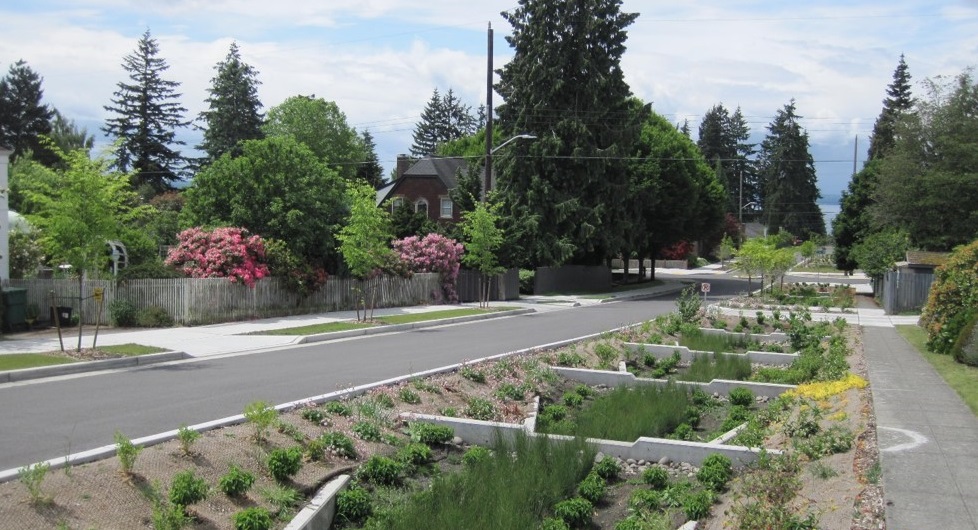Stormwater & residential pollution
One of the main pollution sources from urban and suburban communities is stormwater. Stormwater is rain and snow melt that flows over rooftops, streets, landscaping, and parking lots that can pick up and carry pollution into nearby waterways. Stormwater is not always treated even when it flows into street drains and can be a leading threat to water quality. Due to the significant rain and snow across the state, Washington has become a leader in stormwater management.
Stormwater comes from both point and nonpoint sources
In cities and towns (of a certain size), stormwater is managed by local governments and businesses through our Stormwater Permit Program. Even though rain can fall anywhere, in communities, people can direct where it flows. For example, they could direct it to flow down a drain. We treat this as a point source pollution, meaning it has a known point it flows from. We regulate this type of stormwater with a series of permits that have best practices to control the flow and reduce pollution.
However, that doesn't cover all of the ways rain and snow can runoff and pick up pollution. Rain water that mainly flows over forest land, agriculture land, and towns too small to meet our size requirements do not have a clear point, like a pipe or stormdrain. In these cases, we do not use permits to manage the stormwater pollution. This source of stormwater falls under our Nonpoint Program. We use a combination of technical and financial assistance backed by state and federal laws to address these pollution sources.
What's the problem?
As the population in Washington grows, development increases. More people usually means more homes, more roads, and more pavement. These are impervious surfaces that leave less places for rain and snow melt to soak into the ground and usually have fewer trees to help evaporate the excess water.
Stormwater runoff can carry toxic chemicals, bacteria, and other pollutants. This pollution can contaminate swimming areas, pollute shellfish beds, damage salmon habitat, and contribute to flooding and drought.
Toxic tire dust
One example chemical of concern is 6PPD-quinone. Also known as 6PPDQ, this chemical comes from tire dust as tires wear down from the friction on the road. Tire wear particles then wash into stormwater and are lethal to coho salmon.
What is our role?
For stormwater sources that are regulated as point sources, we issue permits under federal and state laws to control surface and groundwater pollution from runoff. Washington's most populated cities and counties, as well as industrial sites, construction sites, and many businesses have stormwater permits.
To address non-permitted stormwater and pollution we work with other agencies and local partners, such as Conservation Districts, to provide technical and financial assistance, and support public education.
Our work includes:
- Providing guidance and technical assistance on how to meet water quality standards and permit requirements.
- Offering funding for stormwater improvement projects.
- Responding to reported enviornmental issues.
- Coordinating research to determine how effective our best practices are reducing pollution.
- Enforcing, as a last resort, when water quality is being harmed or pollution limits in permits are not met. Penalty fines that we collect go to the state’s general fund or to dedicated pollution prevention accounts.
More information about permits
We use different types of permits depending on the type of business or industry, whether the stormwater flows directly into a waterbody or to a treatement facility. All of our permits have various requirements that aim to control pollution and meet water quality standards. Three major categories of stormwater are permitted by our stormwater general permits that cover the most populated cities and counties municipal stormwater, industrial facilities, and construction sites.
We collect information such as compliance monitoring from permitted facilities, that data is searchable in our Permit and Reporting Information System (PARIS) database.
If you are a permitted facility, interested in applying, changing, implementing, and complying with your stormwater permit, please visit our stormwater permittee guidance page.
Researching the most effective pollution prevention practices
Check out the Stormwater Action Monitoring (SAM) program to learn more about the research on how effective stormwater management is at reducing pollution.
This bioretention facility helps filter water that runs off pavement before it enters the stormwater drain.
What can be done?
For Washington's large cities and towns, local governments are already doing work to reduce stormwater pollution. We support these investments with grant and loan funding, in addition to technical assistance and guidance. You can help by getting involved in your community’s stormwater planning efforts and by supporting the integration of low impact design for new developments and redevelopment.
Protecting Washington's Waters is a job for everyone. Small actions add up and help ensure clean, cool water for all of Washington. Consider the following local actions that can add up to make a big impact:
- Pick up your pet’s waste and throw it in the trash.
- Reduce the use of chemicals in your yard and garden.
- Wash your car on lawn/gravel or take it to a car wash.
- Plant trees and native plants instead of lawns.
Related links
- Learn about stormwater in our environmental guide: Protecting Washington’s waters from stormwater pollution
Contact information
Markus Melton
Stormwater Engineer
markus.melton@ecy.wa.gov
360-701-5580







